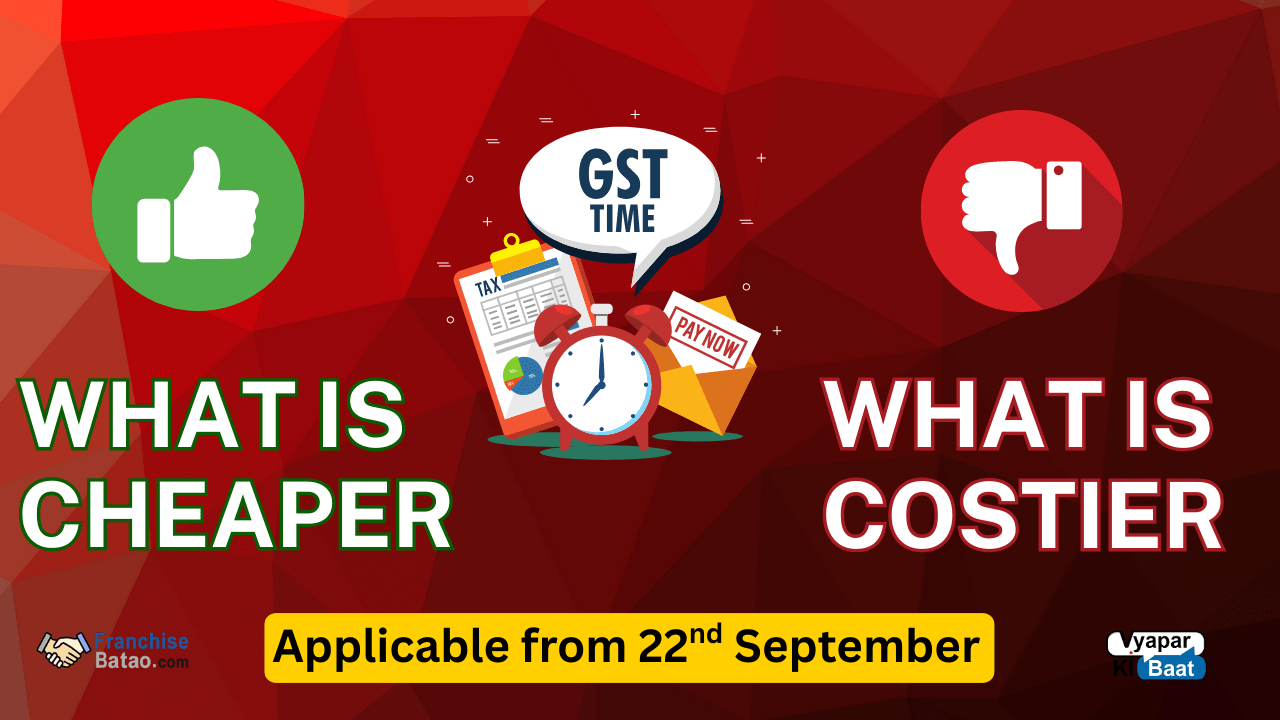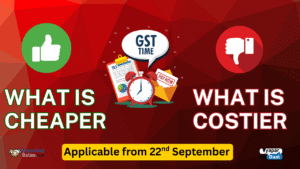GST Slabs at GST council in India

GST Reform in GST Slab rates
How GST Council’s September 3rd Decision is Set to Transform Your Small Business
The biggest tax reform since GST’s inception is here – and it’s bringing early Diwali gifts for Indian entrepreneurs
Picture this: You’re a small business owner who’s been juggling multiple GST slabs, dealing with complex compliance, and watching your working capital get stuck in refund processes. Well, take a deep breath because September 3rd, 2025, just became a landmark date that will change how you do business in India forever.
The Historic GST 2.0 Revolution
On September 3rd, 2025, the GST Council delivered what many are calling the most significant tax reform since GST’s launch in 2017. In a marathon 10.5-hour session, Finance Minister Nirmala Sitharaman announced sweeping changes that will make the Indian tax system simpler, more business-friendly, and remarkably more affordable for the common man.
India is moving from a complicated 4-tier GST structure (5%, 12%, 18%, 28%) to a streamlined 2-tier system (5% and 18%) with a special 40% rate for luxury goods.
But here’s the kicker – these changes take effect from September 22nId, coinciding with the start of Navratri, making this truly a festive gift for Indian businesses.
What’s Getting Cheaper: New Gst Slab
Daily Essentials That Will Shrink Your Bills
Personal Care Items (18% → 5%):
- Hair oil and shampoo
- Toothpaste and toothbrushes
- Soap bars and talcum powder
- Face powder and dental floss
Kitchen & Household Items (12% → 5%):
- Tableware and kitchenware
- Bicycles and umbrellas
- Feeding bottles and utensils
Food Items Getting Major Relief
From 18% to 5%:
- Chocolates and cocoa products
- Ice cream and pastries
- Coffee extracts and tea essences
- Cornflakes and cereals
From 12% to 5%:
- Namkeens and bhujia
- Pasta and instant noodles
- Sauces and preserves
- Packaged drinking water (20-liter bottles)
From 5% to FREE (0% GST):
- Ultra-High Temperature (UHT) milk
- Packaged paneer and chenna
- All Indian breads (chapati, roti, paratha)
- Pizza bread
Transportation & Big-Ticket Items
Vehicles Getting Relief (28% → 18%):
- Small cars (petrol <1200cc, diesel <1500cc, length <4000mm)
- Motorcycles up to 350cc
- Three-wheelers and buses
- Ambulances and trucks
Consumer Electronics (28% → 18%):
- Air conditioners
- Television sets (all sizes now at 18%)
- Dishwashing machines
Healthcare & Insurance Revolution
Complete GST Exemption (18% → 0%):
- All individual life insurance policies
- Health insurance policies (including family floater and senior citizen policies)
Medical Items (12% → 5%):
- Most drugs and medicines
- Medical equipment and devices
- Diagnostic kits and reagents
What’s Getting Costlier: The Premium Price Tag
Sin Goods Face 40% Tax
- Cigarettes and tobacco products
- Pan masala and gutkha
- Aerated beverages and energy drinks
- Luxury cars (>1200cc petrol, >1500cc diesel)
High-End Vehicles (28% → 40%)
- Premium motorcycles (>350cc)
- Luxury cars exceeding size limits
- Yachts and personal aircraft
- Racing cars
The Small Business Bonanza: Why MSMEs Should Celebrate
Working Capital Liberation
The biggest game-changer for small businesses? Resolution of inverted duty structures. Economic Times Previously, many small manufacturers were stuck in situations where they paid higher GST on inputs than on outputs, locking up precious working capital in refund claims.
Real Impact Numbers:
- Nearly 90% of products in the 28% slab moving to 18%
- Almost 99% of items in the 12% slab shifting to 5%
- Fast-track refunds: Claims under inverted duty structures will now be settled within 7 days
Compliance Cost Revolution
Before GST 2.0: Small businesses struggled with:
- Complex 4-tier rate structure
- Frequent rate classification confusion
- Multiple compliance requirements
- Lengthy refund processes
After GST 2.0: Businesses enjoy:
- Simple 2-tier structure (5% and 18%)
- MSME registration in just 3 days
- Clearer product classifications
- 90% provisional refunds for inverted duty structures based on system analysis
Manufacturing Competitiveness Boost
The textile sector, a major MSME employer, gets massive relief with manmade fiber GST reduced from 18% to 5% and manmade yarn from 12% to 5%. This correction of long-pending inverted duty structures will:
- Free up working capital worth thousands of crores
- Improve manufacturing competitiveness
- Support the ‘Atmanirbhar Bharat’ vision ClearTax
The Numbers Game: Financial Impact
The GST Council’s reforms come with a ₹48,000 crore revenue impact, which officials confirm is “fiscally sustainable for both Centre and states.” MoneyControl
What this means for small businesses:
- Enhanced cash flow from faster refunds
- Reduced compliance costs through simplified structure
- Better pricing competitiveness due to lower input costs
- Increased consumer demand as essentials become cheaper
Strategic Timing: Countering Global Challenges
This reform comes at a crucial time when Indian exporters are facing a 50% US tariff on various goods imposed on August 27, 2025. By boosting domestic consumption through lower GST rates, the government is employing a “vocal for local” strategy to offset export challenges and strengthen the domestic market.
Implementation Timeline on new GST Rates

September 22, 2025: New rates for goods and services (except tobacco products)
- MSME registration: 3-day processing starts immediately
- Refund processing: 7-day window for inverted duty structure claims
- GST Appellate Tribunal: Accepting appeals by end-September, hearings by December
What Small Business Owners Should Do Now on GST slabs
mmediate Action Items:
- Review Product Classifications: Understand how your products fit into the new 5% and 18% slabs
- Update Pricing Strategy: Calculate the impact on your cost structure and pricing
- Cash Flow Planning: Prepare for improved working capital from faster refunds
- Compliance Update: Familiarize your team with simplified procedures
- Market Positioning: Leverage lower costs to improve competitiveness
Strategic Opportunities:
- Expand Product Lines: Lower costs on inputs may enable product diversification
- Geographic Expansion: Improved margins could fund market expansion
- Technology Investment: Freed-up working capital can be invested in business growth
- Inventory Optimization: Simplified structure allows better inventory management
The Bigger Picture: Economic Growth Engine
Prime Minister Narendra Modi hailed these reforms as benefiting the “common man greatly,” calling them “wide-ranging reforms” that will improve citizens’ lives while easing business operations. Times of India
Economic multiplier effects expected:
- Increased consumer spending due to lower prices on essentials
- Higher business investments from improved cash flows
- Job creation in MSME sector as businesses expand
- Formalization of more businesses into the tax net
Special Benefits for Key Sectors
Agriculture & Rural Economy
- Tractors and agricultural machinery: 12% → 5%
- Agricultural equipment and tools: Significant reductions
- Rural handicrafts and products: Enhanced competitiveness
Healthcare Democratization
- Complete insurance exemption encouraging wider coverage
- Cheaper medicines and medical devices
- Better access to healthcare services
Housing & Construction
- Cement: 28% → 18% (major construction cost reduction)
- Building materials: Various reductions supporting affordable housing
Looking Ahead: The GST 2.0 Promise
This isn’t just about tax rate changes – it’s about transforming India’s business ecosystem. The GST Council has shown remarkable consensus, with all states unanimously supporting these reforms, indicating strong political will for business-friendly policies.
Key transformational elements:
- Digital Integration: Enhanced online systems for faster processing
- Reduced Litigation: Clearer classifications mean fewer disputes
- Improved Ease of Doing Business: Simpler compliance, faster approvals
- Global Competitiveness: Lower cost structure helps Indian businesses compete globally
Conclusion: Your Business’s New Chapter Begins
September 3rd, 2025, will be remembered as the day when Indian taxation took a giant leap toward simplification and business friendliness. For small business owners, this represents more than just tax savings – it’s an opportunity to reinvent, expand, and thrive in a more supportive business environment.
The message is clear: Indian small businesses are getting the respect and support they deserve. With working capital freed up, compliance simplified, and costs reduced, the only question left is – how will you leverage these changes to grow your business?
The GST 2.0 era begins September 22nd. Are you ready to make the most of it?




